Have you ever attended a dog drafting or carting event? If so, odds are you’ve witnessed a massive bundle of fluff, hauling around two or even three times their weight. The feat seems almost impossible. And then the dog bounds over to their owner with doggie enthusiasm and joy. Beauty, strength, loyalty, and sweetness; it’s the perfect combination! You might find yourself tempted to bring one home (especially if you catch a glimpse of one of those roly-poly puppies!) But when you discover how short the Bernese Mountain Dog lifespan is, you may hesitate. Why don’t these magnificent dogs live very long? Before you bring a Berner home, make sure you understand the potential health risks they bring along.
Mountain Dogs
Believe it or not, Bernese Mountain Dogs are one of four dog breeds that call the canton (a small division of a country) of Bern, Switzerland home. They started as cattle herders, watchdogs on farms, and family pups. (Not much has changed there) People then realized those powerful hind legs were capable of hauling several times the dogs’ own weight. Carting then appeared on the Berner job list. A working dog, the family dog, guard dog – they did it all.
Unfortunately, even with so many credits to their name, the Berners started dwindling in the late 1800s. The Industrial Revolution made mechanical advancements, replacing the work of the dogs. By the time Professor Albert Heim stepped in in 1907, the Swiss breed club’s genetic population wasn’t in the best shape. And that is where some of the problems with the Bernese Mountain Dog lifespan started. You need a broad, diverse gene pool to prevent nasty inheritable traits from creeping in. Still, the Berner fans encouraged a love for the breed to return throughout the area.
In 1926, the first pair of Berners found themselves imported to Kansas. When farmers noted the practical use of the hard-working dogs, they caught on. The AKC registered the first Bernese Mountain Dog in 1937, and now they’re popular entrants in carting and drafting events.
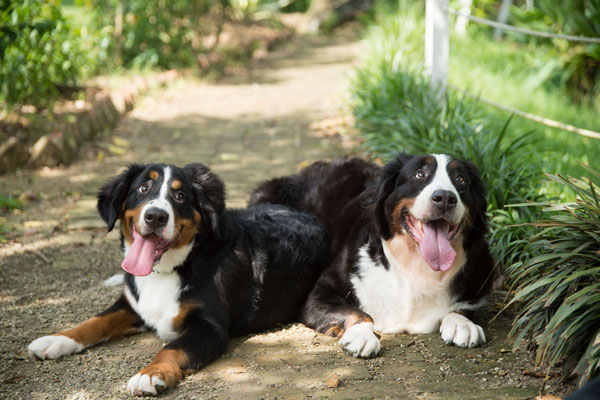
The Bernese Mountain Dog
Considered a giant breed, Bernese Mountain dogs require lots of room – in the house and outside. Females top out around 75-100 pounds, and males reach a staggering 80-120 pounds. Good thing they’re one of the sweeter dog breeds out there. (Though that’s a lot of fluff to land on your lap!) That mountain heritage DOES mean a thick double coat. If you’re not prepared to cope with piles of shed hair and brushing, you’re better off skipping this particular beauty. And while they won’t slobber quite as much as some of the jowly giants, you’ll still cope with drool. Have a towel handy with you at all times if you want to preserve your furniture – or prevent flung strands from hitting the ceiling. (You laugh, but I’ve seen it)
If you want to maximize your Bernese Mountain Dog’s lifespan, you need to stay on top of their exercise needs. At least 30 minutes a day of outdoor movement keeps a slim, trim figure on that massive frame. Stay mindful of the weather, though. All of that hair and high temperatures? Not a good combination. Heatstroke can creep up on these dogs FAST. With their ancestry, they’d much rather stick to colder regions. And if you get them out in the snow, they’ll love you forever.
The Bernese Mountain Dog Lifespan
It’s heartbreaking, but when you consider a lineup of all dog breed lifespans, Berners come in at #3 – on the SHORT end. In fact, the only breeds with shorter anticipated lives are the Great Dane (#1) and the Dogue de Bordeaux (#2). The average Bernese Mountain Dog lifespan is around 7-8 years. In comparison, most giant breeds live 8-12 years. The increased size puts them significantly behind small breeds, who get an average of 10-15 years (Chihuahuas are outliers). It’s a dramatic difference.
So what’s going on? They’re athletic dogs. They have sweet personalities that make them amenable to training and life with families. Sure, they’re big, but other massive dogs don’t pass away early. So what’s bucking the system? Well, remember when the genetic pool in Switzerland dwindled so dramatically? Yeah, those consequences continue today. It turns out genetic diversity really IS important.
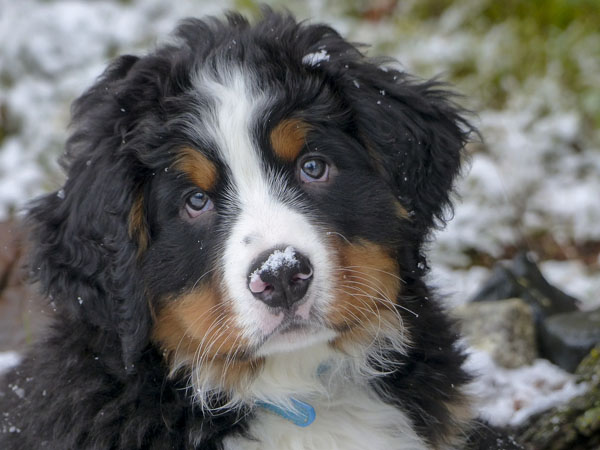
Genetic Conditions
When you look to purchase a Berner from a breeder, the pair of you need to sit down and have a long discussion. And if the person’s reputable, you WILL. The Bernese Mountain Dog Club of America (BMDCA) sees to that. Concerned with that Bernese Mountain Dog lifespan, the BMDCA started collecting data on dog health, breed lines, and causes of death. Why? Because more genetic testing is needed. Currently, the only testing required for Berners checks for the following:
- Cardiac evaluation
- Hip and elbow evaluations
- Ophthalmology evaluation
- von Willebrand’s disease DNA test
And you WANT to see the results of those exams and tests. Because all of them result in genetic conditions that impact the Bernese Mountain Dog lifespan (some worse than others). A breeder that can’t produce the test results (or won’t) is one you need to run away from. They’re contributing to the decline of the breed. Or they may run a puppy mill. And the last thing you want is one of these genetic problems showing up out of the blue.
Hip and Elbow Dysplasia
Dysplasia means a bone or joint that grows abnormally. Inflammation results and causes disabling pain. Berners can develop hip OR elbow dysplasia (or both). Most large or giant breeds run the risk of dysplasia, so responsible breeders screen for the conditions. Radiographs (x-rays) identify the abnormality. Unnoticed, dogs eventually develop lameness, swelling, and changes in their gait. For hip dysplasia, you’ll see a “bunny hop” when your Berner runs. When it comes to the elbow, they usually hold the arm out to the side. Both require surgical correction. And surgery on a dog that big? You’ll need a lot of work post-op. They can’t put weight on the limb during the recovery process. Can YOU lift 120 pounds?
Progressive Retinal Atrophy
Progressive retinal atrophy (PRA) sounds like what it is: the eventual deterioration of the retina. And in Berners, you get two versions: early and late. Early PRA can show up in puppies as young as three months. Late PRA appears when dogs reach 3-5 years. The pupils dilate, dogs become disoriented, and they develop night blindness. Within a year of diagnosis, they become entirely blind. It’s not painful, but the loss of sight can impact a Bernese Mountain Dog’s lifespan if you’re not careful to monitor them. You’ll need to step up your vigilance at all times.
von Willebrand’s Disease
While genetic, von Willebrand’s disease isn’t unique to Berners. It ranks as the most common blood-clotting disorder in dogs. They fail to make one of the factors (von Willebrand) needed for the clotting cascade. So if they receive a cut, the body struggles to form a normal clot. As a result, your Berner can easily bleed to death. You MUST warn your vet of a diagnosis of von Willebrand’s disease. Even an ordinary dental procedure requires them to take special precautions. Needless to say, having this genetic condition can decrease the Bernese Mountain Dog’s lifespan, especially in an accident.
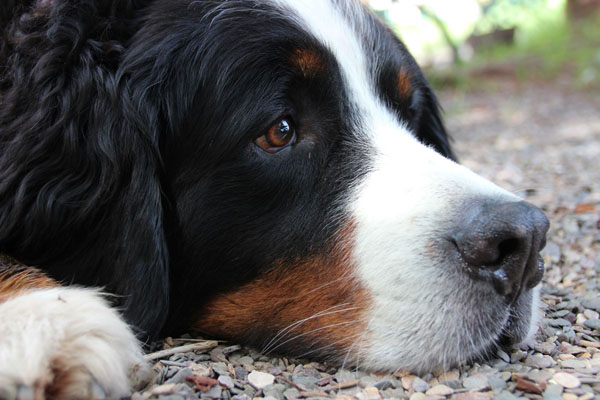
Bernese Mountain Dog Lifespan: The Dreaded C-Word
It’d be nice if the health concerns ended there, wouldn’t it? Seems like more than enough. However, as much as those genetic conditions plague Berner owners, they aren’t the biggest factors driving the lifespan down. Supported by a 2016 Swiss study, the worst fate waiting for Berners is cancer. Most dogs face a cancer risk of around 15%. Berners? The risk goes up to 55%. So the biggest force behind the Bernese Mountain Dog lifespan is cancer.
And it isn’t even one “flavor” of cancer, either. Berners tend to get up to SIX different cancers! It’s the most heartbreaking part of Berner ownership.
Berner Cancers
- Hemangiosarcoma: Hemangiosarcoma targets blood vessels. The biggest affected organs are the base of the heart and spleen. The good news is your dog doesn’t need a spleen. Your vet can go in and remove the spleen when a mass gets detected. The bad news is, by the time most splenic masses get noticed, the cancer’s already metastasized (spread) throughout the body.
- Histiocytic sarcoma: Histiocytes are white blood cells (also known as macrophages). They help clean up infections around the body. But, when they get out of control, they wreak havoc. It’s one of the most aggressive cancers for dogs. And, unfortunately, Berners are known for it.
- Mast Cell: Mast cells are sneaky. They typically present as lumps on the body. Poke them, and they cause a histamine response (think allergic reaction times TEN) in the body. They’re also busily metastasizing throughout the body. In dogs, they’re malignant. In cats, they’re not (unfair, I know).
- Malignant Melanoma: Dark pigmented spots on the skin or mouth are NEVER a good sign – in anyone. And under all of that thick, luxurious hair, they can get missed. This is why skin cancer drops Bernese Mountain Dog lifespans.
- Lymphosarcoma: You’re probably familiar with lymph nodes. Lymph tissue exists throughout the body, though. And when that tissue becomes over-stimulated, problems ensue. You can see enlarged lymph nodes, or you may see other symptoms in your Berner – it depends where the problem begins.
- Osteosarcoma: One of the nastier cancers out there, osteosarcoma invades bones. If the cancer advances, your Berner may present for a broken bone (cancer EATS through the bone). Otherwise, it starts with a limp. (Which isn’t fair, as dysplasia presents with limping, too. See why you need that genetic screening?)
Other Health Concerns
To round out the mix, a few other factors are contributing to the low Bernese Mountain Dog lifespan. (As if these poor dogs don’t already have enough problems) You’ll need to stay on your toes and make sure you get your Berner into the vet for routine visits. If you suspect ANYTHING is out of place, make an appointment. You could save your dog’s life. And you may get a few more years out of the bargain!
Degenerative Myelopathy
As your Berner starts to age, they may develop degenerative myelopathy (DM). The nerves connecting the spine to the muscles of the limbs start to wear down. Suddenly, you have a massive dog dragging their hind legs. Things progress anywhere from six months to a year, and then you have a dog unable to use their hind legs at all. Researchers believe DM is genetic, though there’s no test for it as of yet. And while Berners aren’t the most common breed for it to appear, the age of onset is around eight. Owners with small dogs manage to cope with little trouble, but a 120-pound dog? Things can get tricky.
Renal Dysplasia
There’s that horrible dysplasia word again. This time, the failure in development targets one of the kidneys. The result is a Berner that succumbs to early-onset renal failure. You CAN manage dogs with renal failure (people do it all the time). However, malfunctioning kidneys contribute to Bernese Mountain Dog lifespans dropping. The kidneys help regulate blood cell production, blood pressure, and heart health. If your dog’s struggling with one bum kidney? You can expect them to develop other problems down the road.
Gastric Dilatation and Volvulus
Gastric dilatation and volvulus (GDV) – also known as the dreaded “bloat.” Giant dogs and dogs with deep chests represent the biggest risk for this life-threatening condition (yes, even small guys like Dachshunds). The usual scenario tends to play out like this:
- Your dog eats a large meal. Sometimes, they get into the bag of dog food on their own.
- Something causes them to race around immediately afterward (say, you chasing them away from the bag).
- In the process, the stomach swings around in the rib cage. Eventually, it FLIPS, closing off blood vessels and the valve connecting the stomach and esophagus.
- You notice your dog retching, attempting to vomit without success. Their stomach expands.
GDV represents a SEVERE emergency. Without surgical intervention, the dog will die. Do not pass Go, do not collect $200 (um, actually, you’ll need to collect WAY more than that). Get to the vet ASAP.
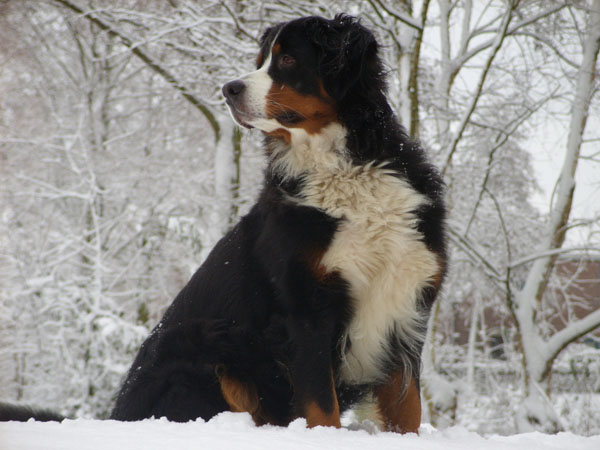
Choosing a Berner
You love Berners. You want to add one to your life. But that Bernese Mountain Dog lifespan is scaring you. Is there something you can do to help your pup? Of course!
The BMDCA knows the breed needs work. They’re coordinating with their breeders toward a solution. And you can talk to your chosen breeder about the lifespan of their dogs. Choose a puppy from a line with longer lives. Something in that genetic code is working, after all!
Stay on top of your Berner’s health. Don’t allow your dog to carry extra weight that can stress their joints. Regular exercise and healthy food portions keep ANY dog living well through their twilight years. And establish a strong relationship with your vet. Skipping vaccines or routine lab work can land you in hot water down the road.
Spay or neuter your dog. Spayed females have the record on the Bernese Mountain Dog lifespan. And while they’re still working on determining the link, dogs with early neutering or spaying are less likely to develop osteosarcomas, in general.
Put in the research and effort, and you may find yourself joining Verena Wulf in the record books. Her Berner, Penny, lived to 25 years! (And she had the ear tattoo to prove her birth year of 1986)
Sweet, Short-Lived Giants
Maybe the Bernese Mountain Dog lifespan isn’t the most impressive one out there. You WILL need to keep a lot of health concerns in mind. Does that mean you should count the breed out? Of course not. They have so many admirers working to solve the riddle behind the genetic problems. And if you’re willing to form a bond with your vet and offer proper care? Nothing’s impossible.
And, really, how do you say no to that sweet, fluffy face?

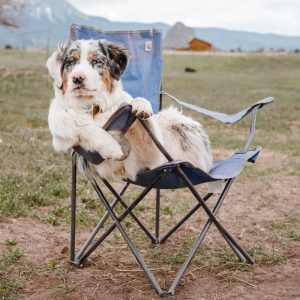









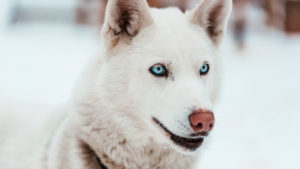

4 Comments
I don’t know why this stigma still exists. This may have been true 20 years ago but of all the Berner groups I’m part of have dogs living on average much longer. Many Berners live into their teens. I’d say the avg is 8-10 nowadays at least. Sure they can have all the issues mentioned but I think everyone trys hard to prevent any of it.
Dalton,
I’m glad you’re a part of groups that have successfully seen Berners survive longer. It’s one of the reasons I recommended that people interested in the breed discuss lifespans with their breeders. However, the lifespan I reported is accurate. The study I referenced is from 2016, and the Bernese Mountain Dog Health Symposium in 2018 met to find ways to help boost the lifespan numbers. While some dogs (Penny’s a terrific example) fall outside, lifespan averages look at the overall population. People are working to improve things, but the average lifespan across the entire Berner lifespan is still reported as 7-8 years. The groups you participate in certainly sound like they’re working toward the solution, which is fantastic. Hopefully, through the work of the BMDCA, things will start to improve.
~Andria
I have had dogs all my life and I love every breed but Berners are super special to me….I’m on my third. If you’re considering a Berner make sure your breeder is a BMDCA member and submits DNA to The Berner Guarde Foundation.
David,
I think that’s an excellent plan. They’re gorgeous breeds, and the Berner Guarde Foundation is doing fantastic work – thanks for mentioning them!
~Andria